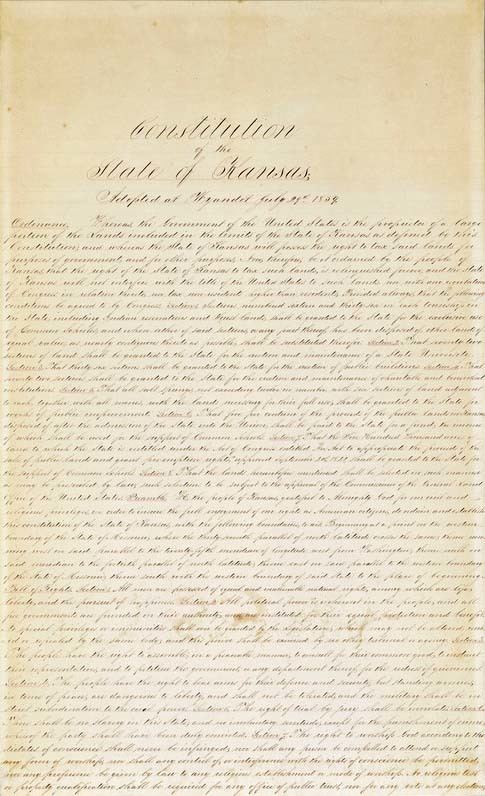Created July 29, 1859 | Ratified January 29, 1861 | |
 | ||
Location State Library of Kansas | ||
The present Constitution of the State of Kansas was originally known as the Wyandotte Constitution to distinguish it from earlier proposed state constitutions. Drawn up at Wyandotte (now part of Kansas City) in July 1859, it was the fourth constitution voted on by the people of Kansas Territory, as the battle between proslavery and antislavery forces during the Bleeding Kansas era spread to the debate over the terms of the new state's charter.
Contents
Adoption
The Wyandotte Constitution was approved in a referendum by a vote of 10,421 to 5,530 on October 4, 1859. In April, 1860, the United States House of Representatives voted 134 to 73 to admit Kansas under the Wyandotte Constitution; however, there was resistance in the United States Senate. As 11 slave states seceded from the Union, their senators left their seats and on January 21, 1861, the Senate passed the Kansas bill. The admission of Kansas as a free state became effective January 29, 1861.
Terms
The constitution settled the terms of Kansas' admission to the United States, particularly establishing that it would be a free state rather than a slave state. The constitution represented a pragmatic compromise over hotly contested issues: it rejected slavery and affirmed separate property rights for married women and their right to participate in school elections, but also denied universal suffrage for women, blacks, and Indians.
Solon O. Thacher of Lawrence gave a rousing speech opposing the exclusion of African-Americans from Kansas. The motion to exclude was defeated despite the fact that all the Democrats and a few of the Republicans favored the exclusion.
Another issue delegates considered was that of women’s rights. Clarina Nichols, social activist and associated editor of Quindaro Chindowan, an abolitionist newspaper, was asked to address the convention. As a result of her efforts, women gained the rights to own property and to participate in school district elections. In addition, the constitution assured that the state would provide for women’s equal rights “in the possession of their children.”
The previous proposed state constitutions were the Topeka Constitution of 1855, the Lecompton Constitution of 1857 and the Leavenworth Constitution of 1858.
Amended many times (including a universal suffrage amendment in 1912), the Wyandotte Constitution is still the constitution of Kansas.
Slavery is prohibited: "SEC. 6. There shall be no slavery in this State, and no involuntary servitude, except for the punishment of crime, whereof the party shall have been duly convicted."
Preamble
Kansas's constitution is the only state constitution to attempt to recognize "civil privileges" through "Almighty God" distinct from rights of citizens of the United States. The preamble also conflates "America" with "United States" in its reference to seeking "to insure the full enjoyment of our rights as American citizens" rather than citizens of the United States.
